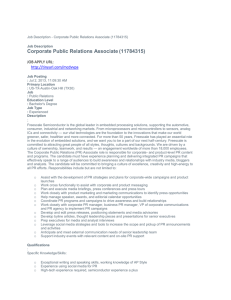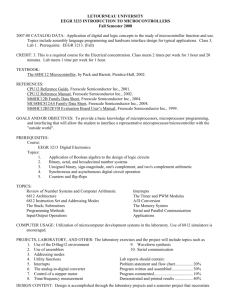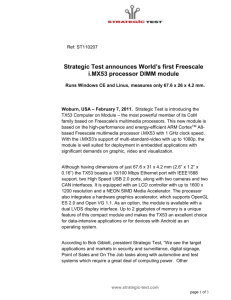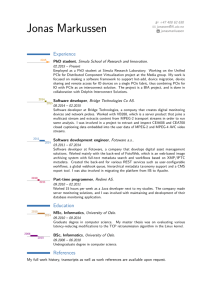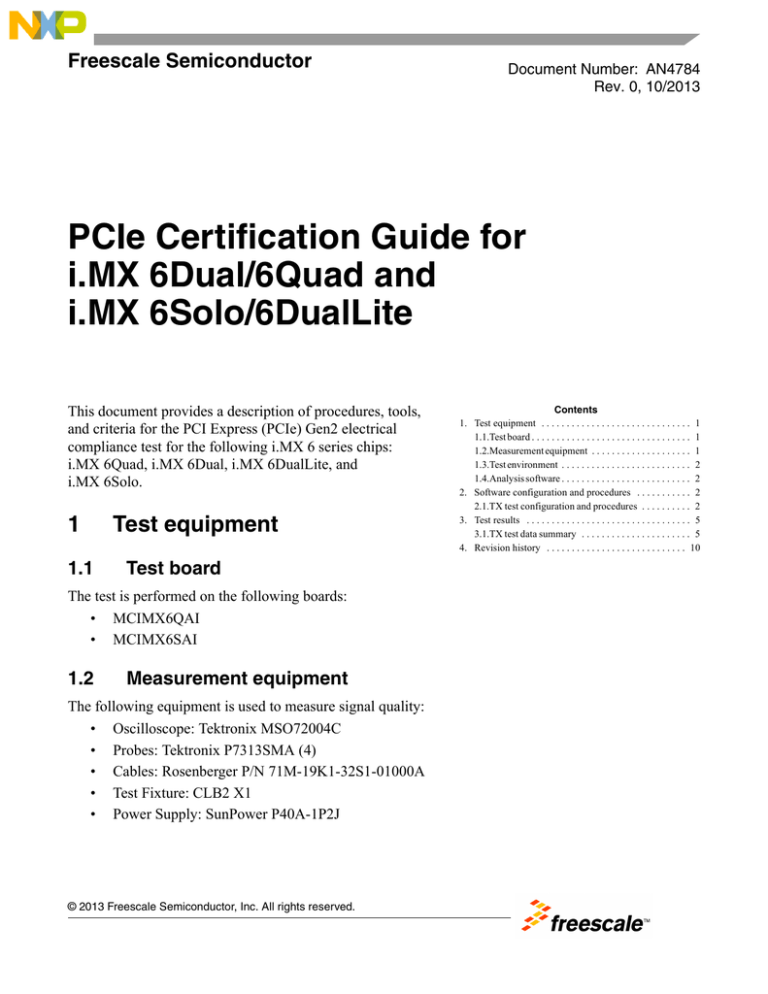
Freescale Semiconductor
Document Number: AN4784
Rev. 0, 10/2013
PCIe Certification Guide for
i.MX 6Dual/6Quad and
i.MX 6Solo/6DualLite
This document provides a description of procedures, tools,
and criteria for the PCI Express (PCIe) Gen2 electrical
compliance test for the following i.MX 6 series chips:
i.MX 6Quad, i.MX 6Dual, i.MX 6DualLite, and
i.MX 6Solo.
1
1.1
Test equipment
Test board
The test is performed on the following boards:
• MCIMX6QAI
• MCIMX6SAI
1.2
Measurement equipment
The following equipment is used to measure signal quality:
• Oscilloscope: Tektronix MSO72004C
• Probes: Tektronix P7313SMA (4)
• Cables: Rosenberger P/N 71M-19K1-32S1-01000A
• Test Fixture: CLB2 X1
• Power Supply: SunPower P40A-1P2J
© 2013 Freescale Semiconductor, Inc. All rights reserved.
Contents
1. Test equipment . . . . . . . . . . . . . . . . . . . . . . . . . . . . . . 1
1.1.Test board . . . . . . . . . . . . . . . . . . . . . . . . . . . . . . . . 1
1.2.Measurement equipment . . . . . . . . . . . . . . . . . . . . 1
1.3.Test environment . . . . . . . . . . . . . . . . . . . . . . . . . . 2
1.4.Analysis software . . . . . . . . . . . . . . . . . . . . . . . . . . 2
2. Software configuration and procedures . . . . . . . . . . . 2
2.1.TX test configuration and procedures . . . . . . . . . . 2
3. Test results . . . . . . . . . . . . . . . . . . . . . . . . . . . . . . . . . 5
3.1.TX test data summary . . . . . . . . . . . . . . . . . . . . . . 5
4. Revision history . . . . . . . . . . . . . . . . . . . . . . . . . . . . 10
Software configuration and procedures
1.3
•
•
1.4
•
1.5
•
•
•
2
Test environment
Operation System: Linux L3.0.35_12.11.01_GA
Additional software changes for PCIe compliance test based on L2.6.35_1.0.0 are required. To
access software changes and updated test images, visit
https://community.freescale.com/docs/DOC-94923.
Analysis software
SigTest Version 3.1.60
Additional information
Test items: only contains the electrical test
Test method and equipment operation:
— See PCI Express® Architecture PHY Test Specification, rev. 2.0. (PCI-SIG: 2008, pcisig.com .
— See document #CLB_USAGE_DOC_Rev_1_4_DSA72000b, PCI Express 2.0 CEM System
Signal Quality and Reference Clock Jitter Test Methodology using Tektronix
MSO/DPO/DSA72004 (20GHz), MSO/DPO/DSA71604 (16GHz) and MSO/DPO/DSA71254
(12.5GHz) Real Time Oscilloscopes, rev. 1.4 (PCI-SIG, 2011; register at pcisig.com to
download this document).
100 MHz reference clock: internal PLL clock1
Software configuration and procedures
2.1
TX test configuration and procedures
The following is an overview of the test steps:
1. Integrate the patch for the PCIe test to the mainline, recompile the kernel image2, and replace the
old image of the board under the test.
Make sure the following configuration has been set when recompiling the kernel image.
# MX6 Options:
CONFIG_IMX_PCIE=y
1. The default clock source is the internal PLL clock. By default, the Linux BSP does not support the external 100 Mhz
oscillator. Contact your local Freescale representative for support to use the external oscillator.
2. This patch only removes the clks/power release codes. For information on how to compile the kernel image, see
either the i.MX 6Dual/6Quad SABRE-SD Linux User’s Guide (IMX6DQLXUGSSD) (for i.MX 6Quad or
i.MX 6Dual) or the i.MX 6Solo/6DualLite SABRE-SDP Linux User’s Guide (IMX6DLLXUGSSD) (for
i.MX 6DualLite and i.MX 6Solo) accompanying the Freescale Linux board support package (BSP).
PCIe Certification Guide for i.MX 6Dual/6Quad and i.MX 6Solo/6DualLite, Rev. 0
2
Freescale Semiconductor
Software configuration and procedures
2. Correctly set up the test environment:
• Connect the compliance load board (CLB x1/x16) revision 2.0 into the DUT slot. Then, change
the switch and jumpers to select x1 mode.1
• Connect the lane under the test to the oscilloscope using a differential probe and matching coaxial
cable1. The cable calibration should be done before the test.
• Connect the clock signal to the oscilloscope. The clock must have the SSC enabled or disabled
to be consistent with the settings for the system during normal operation.
• Start up the system.
3. After i.MX 6 enters the polling.compliance stage2, press the toggle button on CLB to select the
output mode3. Ensure the data waveform is compliant with the pattern 5.0 GT/s for Gen2, and
2.5 GT/s for Gen1.
4. Follow operation instructions for the oscilloscope and ensure it is set to the right mode.
5. Capture and save at least 1 million * 200 ps of data while simultaneously clocking at the sample
rate of 50 GS/s for Gen2, or 250,000 UI * 400 ps of data at the sample rate of 25 GS/s for Gen1.
6. Run free software SigTest to analyze the PCIE TX signal.
7. The parameters of PCIe_PHY can be adjusted by changing the IOMUXC_GPR8 register settings
to get the test passed.
a) [Code] The register default is configured as:
imx_pcie_clrset(IOMUXC_GPR8_TX_DEEMPH_GEN1, 0 << 0, IOMUXC_GPR8);
imx_pcie_clrset(IOMUXC_GPR8_TX_DEEMPH_GEN2_3P5DB, 0 << 6, IOMUXC_GPR8);
imx_pcie_clrset(IOMUXC_GPR8_TX_DEEMPH_GEN2_6DB, 20 << 12, IOMUXC_GPR8);
imx_pcie_clrset(IOMUXC_GPR8_TX_SWING_FULL, 127 << 18, IOMUXC_GPR8);
imx_pcie_clrset(IOMUXC_GPR8_TX_SWING_LOW, 127 << 25, IOMUXC_GPR8);
b) [Command line entry after Linux boot] For register address, 20E_0000h base + 20h offset =
20E_0020h, write the command:
/unit_tests/memtool -32 0x020e0020= FFFD4000
8. Detailed information of the related register, IOMUXC_GPR8, is provided in the following table:
1. See the connection and configuration information in document #CLB_USAGE_DOC_Rev_1_4_DSA72000b
(PCI-SIG, 2011, pp. 11–14).
2. After a far-end termination is determined to be present, the Link Training and Status State Machine (LTSSM) enters
the polling.compliance state and begins transmitting the compliance pattern on all lanes. Users do not need to enter
any command to force the system into the polling.compliance state after boot.
3. See the operation information in #CLB_USAGE_DOC_Rev_1_4_DSA72000b (PCI-SIG, 2011, p. 22).
PCIe Certification Guide for i.MX 6Dual/6Quad and i.MX 6Solo/6DualLite, Rev. 0
Freescale Semiconductor
3
Software configuration and procedures
Table 2-1. IOMUXC GPR8 filed descriptions
Field
Description
31–25
PCS_TX_SWING_LOW
PCIe_PHY–This static value sets the launch amplitude of the transmitter when
pipe0_tx_swing is set to 1’b0 (default state).
7’hxx–TX launch amplitude swing_low value.
24–18
PCS_TX_SWING_FULL
PCIe_PHY–This static value sets the TX driver to SWING_FULL value.
7’hxx–Gen2 TX SWING FULL value.
17–12
PCS_TX_DEEMPH_GEN2_6DB
PCIe_PHY–This static value sets the TX driver de-emphasis value in the case where
pipe0_tx_deemph is set to 1’b0 and the PHY is running at the Gen2 (6db) rate.
6’hxx–Gen2 (6db) de-emphasis value.
11–6
PCIe_PHY–This static value sets the TX driver de-emphasis value in the case where
PCS_TX_DEEMPH_GEN2_3P5DB pipe0_tx_deemph is set to 1’b1 (the default setting) and the PHY is running at the Gen2
(3p5db) rate.
6’hxx–Gen2 de-emphasis value.
5–0
PCS_TX_DEEMPH_GEN1
PCIe_PHY–This static value sets the TX drvier de-emphasis value in the case where
pipe0_tx_deemph is set to 1’b1 (the default setting) and the PHY is running at the Gen1
rate.
6’hxx–Gen1 de-emphasis value.
PCIe Certification Guide for i.MX 6Dual/6Quad and i.MX 6Solo/6DualLite, Rev. 0
4
Freescale Semiconductor
Test results
3
3.1
Test results
TX test data summary
The i.MX 6 silicon passes all TX electrical tests. The following measurements show performance criteria.
Figure 1. SigTest test main window
PCIe Certification Guide for i.MX 6Dual/6Quad and i.MX 6Solo/6DualLite, Rev. 0
Freescale Semiconductor
5
Test results
Figure 2. GEN2 -3.5dB TX SigTest test result
The generated HTML report is as follows:
Overall SigTest result: pass
• Mean unit interval (ps): 200.01344
• Min time between crossovers (ps): 170.25641
• Data rate (Gb/s): 4.999664
• Max peak to peak jitter: 62.950002 ps
• Total jitter at BER of 10E-12: 73.516193 ps
• Total jitter at BER of 10E-12 passes SigTest limits
PCIe Certification Guide for i.MX 6Dual/6Quad and i.MX 6Solo/6DualLite, Rev. 0
6
Freescale Semiconductor
Test results
•
•
•
•
•
•
•
•
•
•
•
•
•
•
•
•
•
•
•
•
•
•
•
•
•
Minimum eye width: 126.483807 ps
Deterministic jitter delta-delta: 33.503596 ps
Deterministic jitter delta-delta passes SigTest limits
Random jitter (RMS): 2.845846 ps
Random jitter (RMS) passes SigTest limits
Minimum transition eye voltage: -0.378 volts
Minimum transition eye voltage passes SigTest limits
Maximum transition eye voltage: 0.376 volts
Maximum transition eye voltage passes SigTest limits
Minimum nontransition eye voltage: -0.41 volts
Minimum nontransition eye voltage passes SigTest limits
Maximum nontransition eye voltage: 0.41 volts
Maximum nontransition eye voltage passes SigTest limits
Composit eye height: 0.412434
Composit eye location: 0.5
Minimum transition eye voltage margin above eye: 0.080856 volts
Minimum transition eye voltage margin above eye passes SigTest limits
Minimum transition eye voltage margin below eye: -0.081577 volts
Minimum transition eye voltage margin below eye passes SigTest Limits
Minimum transition eye height: 0.412434 volts
Minimum nontransition eye voltage margin above eye: 0.155389 volts
Minimum nontransition eye voltage margin above eye passes SigTest limits
Minimum nontransition eye voltage margin below eye: -0.150638 volts
Minimum nontransition eye voltage margin below eye passes SigTest limits
Minimum nontransition eye height: 0.556027 volts
PCIe Certification Guide for i.MX 6Dual/6Quad and i.MX 6Solo/6DualLite, Rev. 0
Freescale Semiconductor
7
Test results
Figure 3. Gen2 TX -3.5dB Worst nontransition signal eye
Figure 4. Gen2 -3.5dB Worst transition signal eye
PCIe Certification Guide for i.MX 6Dual/6Quad and i.MX 6Solo/6DualLite, Rev. 0
8
Freescale Semiconductor
Test results
Figure 5. Gen1 TX -3.5dB Worst nontransition signal eye
Figure 6. Gen2 -3.5dB Worst transition signal eye
PCIe Certification Guide for i.MX 6Dual/6Quad and i.MX 6Solo/6DualLite, Rev. 0
Freescale Semiconductor
9
Revision history
4
Revision history
The following table provides a revision history for this application note.
Table 4-1. Revision History
Rev. Number
0
Date
8/2013
Substantive Change
Initial release
PCIe Certification Guide for i.MX 6Dual/6Quad and i.MX 6Solo/6DualLite, Rev. 0
10
Freescale Semiconductor
How to Reach Us:
Information in this document is provided solely to enable system and software
Home Page:
freescale.com
implementers to use Freescale products. There are no express or implied copyright
Web Support:
freescale.com/support
information in this document.
licenses granted hereunder to design or fabricate any integrated circuits based on the
Freescale reserves the right to make changes without further notice to any products
herein. Freescale makes no warranty, representation, or guarantee regarding the
suitability of its products for any particular purpose, nor does Freescale assume any
liability arising out of the application or use of any product or circuit, and specifically
disclaims any and all liability, including without limitation consequential or incidental
damages. “Typical” parameters that may be provided in Freescale data sheets and/or
specifications can and do vary in different applications, and actual performance may
vary over time. All operating parameters, including “typicals,” must be validated for each
customer application by customer’s technical experts. Freescale does not convey any
license under its patent rights nor the rights of others. Freescale sells products pursuant
to standard terms and conditions of sale, which can be found at the following address:
freescale.com/SalesTermsandConditions.
Freescale, the Freescale logo, and the Energy Efficient Solutions logo are trademarks
of Freescale Semiconductor, Inc., Reg. U.S. Pat. & Tm. Off. All other product or service
names are the property of their respective owners. ARM is the registered trademark of
ARM Limited.
© 2013 Freescale Semiconductor, Inc.
Document Number: AN4784
Rev. 0
10/2013


